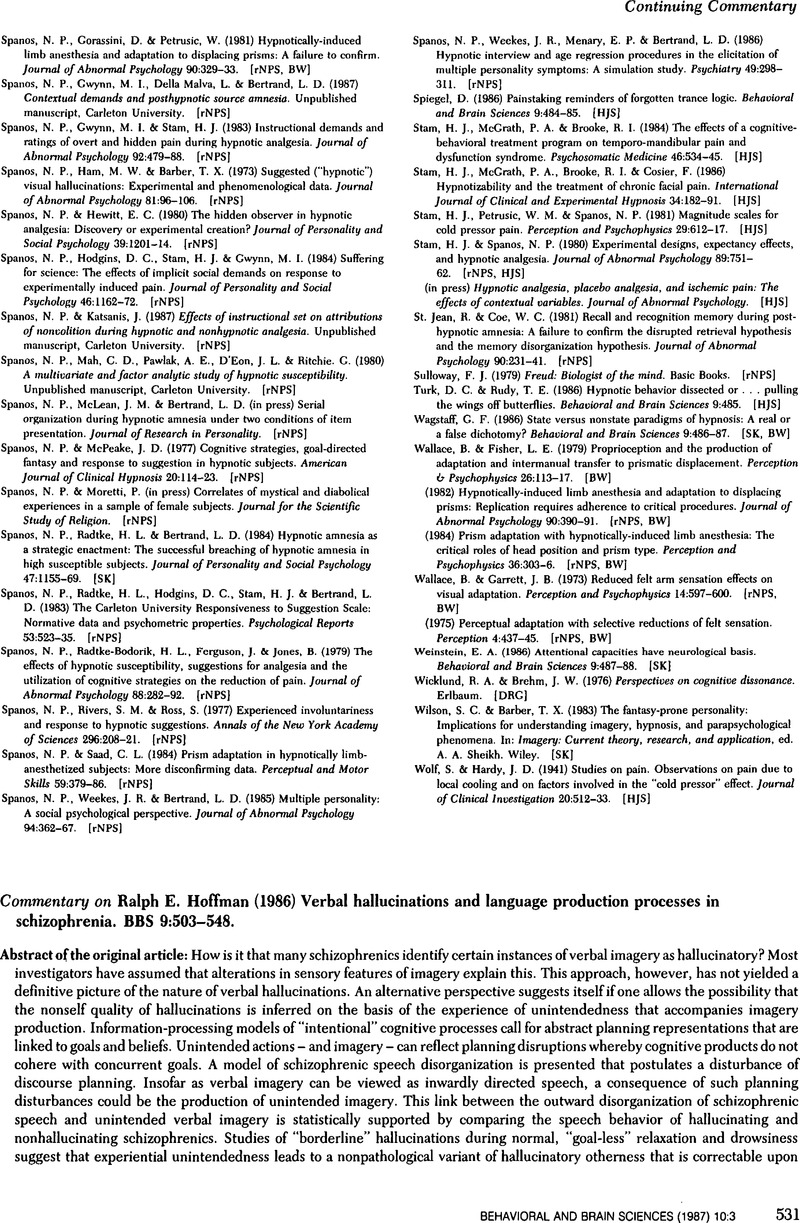Crossref Citations
This article has been cited by the following publications. This list is generated based on data provided by Crossref.
Stevens, Janice R.
and
Gold, James M.
1991.
What is schizophrenia?.
Behavioral and Brain Sciences,
Vol. 14,
Issue. 1,
p.
50.
Weiner, Ina
1991.
The accumbens–substantia nigra pathway, mismatch and amphetamine.
Behavioral and Brain Sciences,
Vol. 14,
Issue. 1,
p.
54.
Sandyk, Reuven
and
Kay, Stanley R.
1991.
The significance of the basal ganglia for schizophrenia.
Behavioral and Brain Sciences,
Vol. 14,
Issue. 1,
p.
45.
Gray, J. A.
Hemsley, D. R.
Feldon, J.
Gray, N. S.
and
Rawlins, J. N. P.
1991.
Schiz bits: Misses, mysteries and hits.
Behavioral and Brain Sciences,
Vol. 14,
Issue. 1,
p.
56.
Cools, A. R.
and
Ellenbroek, B.
1991.
The limbic-striatal interaction: A seesaw rather than a tandem.
Behavioral and Brain Sciences,
Vol. 14,
Issue. 1,
p.
22.
Schmajuk, Nestor A.
and
DiCarlo, James J.
1991.
A hippocampal theory of schizophrenia.
Behavioral and Brain Sciences,
Vol. 14,
Issue. 1,
p.
47.
Early, Terrence S.
Haller, John Wayne
and
Posner, Michael
1991.
Dopaminergic excess or dysregulation?.
Behavioral and Brain Sciences,
Vol. 14,
Issue. 1,
p.
26.
Harrow, Martin
and
Silverstein, Marshall
1991.
The role of long-term memory (LTM) and monitoring in schizophrenia: Multiple functions.
Behavioral and Brain Sciences,
Vol. 14,
Issue. 1,
p.
30.
Nuechterlein, Keith H.
and
Green, Michael Foster
1991.
Neuropsychological vulnerability or episode factors in schizophrenia?.
Behavioral and Brain Sciences,
Vol. 14,
Issue. 1,
p.
37.
Sarter, Martin
1991.
Dopamine-GABA-cholinergic interactions and negative schizophrenic symptomatology.
Behavioral and Brain Sciences,
Vol. 14,
Issue. 1,
p.
46.
Pilowsky, Lyn
and
Murray, Robin M.
1991.
Why don't preschizophrenic children have delusions and hallucinations?.
Behavioral and Brain Sciences,
Vol. 14,
Issue. 1,
p.
41.
Carlsson, Arvid
and
Carlsson, Maria
1991.
A faulty negative feedback control underlies the schizophrenic syndrome?.
Behavioral and Brain Sciences,
Vol. 14,
Issue. 1,
p.
20.
Venables, Peter H.
1991.
Positiwe and negatiwe symptoms, the hippocampus and P3.
Behavioral and Brain Sciences,
Vol. 14,
Issue. 1,
p.
53.
Crider, Andrew
1991.
Motor disturbances in schizophrenia.
Behavioral and Brain Sciences,
Vol. 14,
Issue. 1,
p.
22.
Raine, Adrian
and
Cannon, Tyrone D.
1991.
Neuro-developmental, brain imaging and psychophysiological perspectives on the neuropsychology of schizophrenia.
Behavioral and Brain Sciences,
Vol. 14,
Issue. 1,
p.
43.
Gray, J. A.
Feldon, J.
Rawlins, J. N. P.
Hemsley, D. R.
and
Smith, A. D.
1991.
The neuropsychology of schizophrenia.
Behavioral and Brain Sciences,
Vol. 14,
Issue. 1,
p.
1.
Gewirtz, Jonathan C.
1991.
Novelty value in associative learning.
Behavioral and Brain Sciences,
Vol. 14,
Issue. 1,
p.
29.
Oke, Arvin F.
and
Adams, Ralph N.
1991.
Is another loop needed to explain schizophrenia?.
Behavioral and Brain Sciences,
Vol. 14,
Issue. 1,
p.
39.
Spohn, Herbert E.
1991.
A plausible theory marred by certain inconsistencies.
Behavioral and Brain Sciences,
Vol. 14,
Issue. 1,
p.
49.
Goldberg, Elkhonon
1991.
Schizophrenia and stored memories: Left hemisphere dysfunction after all?.
Behavioral and Brain Sciences,
Vol. 14,
Issue. 1,
p.
30.





